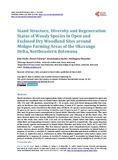| dc.description.abstract | Stand structure, diversity and regeneration status of woody species were investigated in open and exclosed dry woodland sites in Island Safari, Shorobe and Xobe, northeastern Botswana. A total of 105, 111 and 130 quadrats, measuring 20 × 20 m each, were laid down along parallel line transects in the three sites, respectively, to collect data. A total of 47 species, representing 16 families and 24 genera, were recorded in the study sites. Of these, 33 species representing 13 families and 20 genera, 41 species representing 15 families and 23 genera and 27 species representing 10 families and 14 genera were encountered in Island Safari, Shorobe and Xobe, respectively. The most diverse family was Fabaceae followed by Combretaceae and Tiliaceae at all the three sites. The most diverse genus was Acacia, followed by Combretum and Grewia. The diversity of woody species in the study sites were 2.18, 2.15 and 1.5 in Shorobe, Island Safari and Xobe, respectively, while their corresponding evenness values were 0.6, 0.6 and 0.5, respectively. The mean densities of the woody species encountered in Island Safari, Shorobe and Xobe were 2629, 4271 and 2745 individuals ha−1, respectively. The five densest species were Colophospermum mopane, Dichrostachys cinerea, Acacia tortilis, Philenoptera violacea and Terminalia prunioides in Island Safari, C. mopane, A. tortilis, A. erioloba, P. violacea and D. cinerea in Shorobe and Acacia mellifera, A. tortilis, P. nelsii, A. luederitzii and A. erubescens in Xobe. The highest important value index values were exhibited by C. mopane, D. cinerea, A. tortilis, P. violacea and T. prunioides in Island Safari, C. mopane, A. erioloba, A. tortilis, P. violacea and C. imberbe in Shorobe, and A. mellifera, A. tortilis, P. nelsii and A. luederitzii in Xobe. The alarming result was the fact that 71%, 80% and 85% of the woody species recorded in Island Safari, Shorobe and Xobe, respectively, exhibited hampered regeneration and, thus, unhealthy population structures. Therefore, there is an urgent need to address the observed unhealthy population structures of the woody species through investigation of the major causes of their hampered regeneration, and also designing measures that will facilitate natural and artificial regeneration of these species at the three study sites. | en_US |

